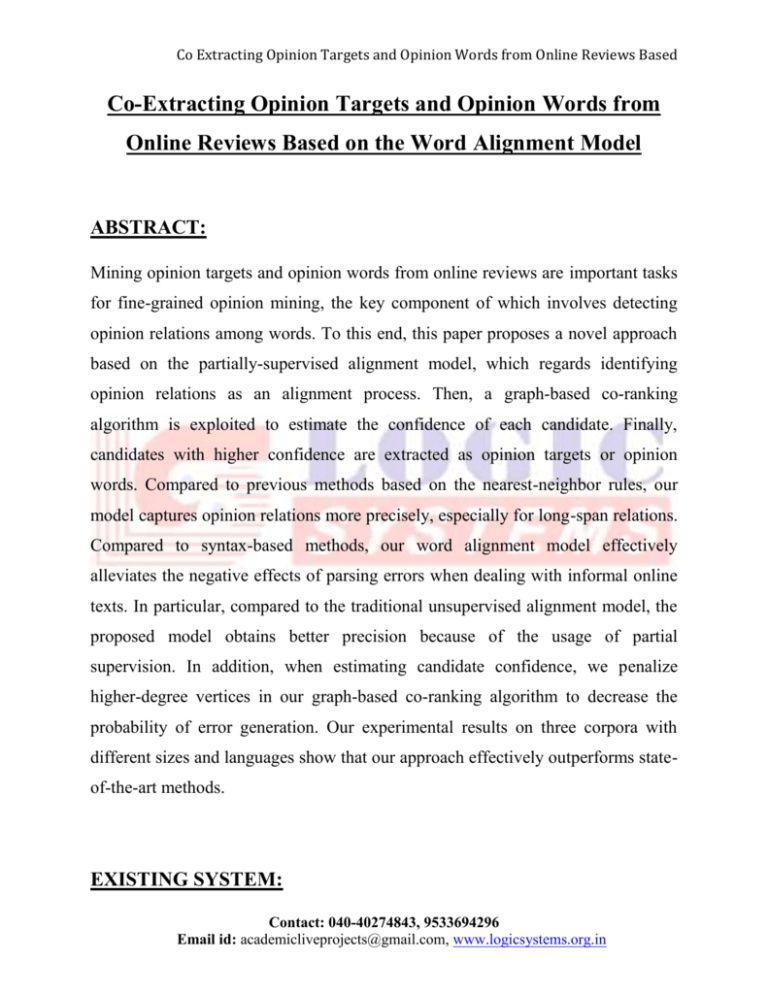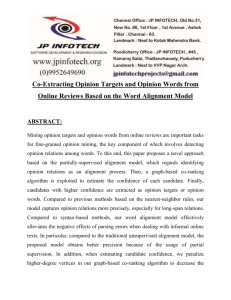Co-Extracting Opinion Targets and Opinion Words
advertisement

Co Extracting Opinion Targets and Opinion Words from Online Reviews Based Co-Extracting Opinion Targets and Opinion Words from Online Reviews Based on the Word Alignment Model ABSTRACT: Mining opinion targets and opinion words from online reviews are important tasks for fine-grained opinion mining, the key component of which involves detecting opinion relations among words. To this end, this paper proposes a novel approach based on the partially-supervised alignment model, which regards identifying opinion relations as an alignment process. Then, a graph-based co-ranking algorithm is exploited to estimate the confidence of each candidate. Finally, candidates with higher confidence are extracted as opinion targets or opinion words. Compared to previous methods based on the nearest-neighbor rules, our model captures opinion relations more precisely, especially for long-span relations. Compared to syntax-based methods, our word alignment model effectively alleviates the negative effects of parsing errors when dealing with informal online texts. In particular, compared to the traditional unsupervised alignment model, the proposed model obtains better precision because of the usage of partial supervision. In addition, when estimating candidate confidence, we penalize higher-degree vertices in our graph-based co-ranking algorithm to decrease the probability of error generation. Our experimental results on three corpora with different sizes and languages show that our approach effectively outperforms stateof-the-art methods. EXISTING SYSTEM: Contact: 040-40274843, 9533694296 Email id: academicliveprojects@gmail.com, www.logicsystems.org.in Co Extracting Opinion Targets and Opinion Words from Online Reviews Based In previous methods, mining the opinion relations between opinion targets and opinion words was the key to collective extraction. To this end, the most adopted techniques have been nearest-neighbor rules and syntactic patterns. Nearest neighbor rules regard the nearest adjective/verb to a noun/noun phrase in a limited window as its modifier. Syntactic information, in which the opinion relations among words are decided according to their dependency relations in the parsing tree. DISADVANTAGES OF EXISTING SYSTEM: Nearest neighbor rules strategy cannot obtain precise results because there exist long-span modified relations and diverse opinion expressions. Syntactic patterns are prone to errors. Online reviews usually have informal writing styles, including grammatical errors, typographical errors, and punctuation errors. This makes the existing parsing tools, which are usually trained on formal texts such as news reports, prone to generating errors. The collective extraction adopted by most previous methods was usually based on a bootstrapping framework, which has the problem of error propagation PROPOSED SYSTEM: To precisely mine the opinion relations among words, we propose a method based on a monolingual word alignment model (WAM). An opinion target can find its corresponding modifier through word alignment. We further notice that standard word alignment models are often trained in a completely unsupervised manner, which results in alignment quality that Contact: 040-40274843, 9533694296 Email id: academicliveprojects@gmail.com, www.logicsystems.org.in Co Extracting Opinion Targets and Opinion Words from Online Reviews Based may be unsatisfactory. We certainly can improve alignment quality by using supervision. However, it is both time consuming and impractical to manually label full alignments in sentences. Thus, we further employ a partially-supervised word alignment model (PSWAM). We believe that we can easily obtain a portion of the links of the full alignment in a sentence. These can be used to constrain the alignment model and obtain better alignment results. To obtain partial alignments, we resort to syntactic parsing. To alleviate the problem of error propagation, we resort to graph co-ranking. Extracting opinion targets/ words is regarded as a co-ranking process. Specifically, a graph, named as Opinion Relation Graph, is constructed to model all opinion target/word candidates and the opinion relations among them. ADVANTAGES OF PROPOSED SYSTEM: Compared to previous nearest-neighbor rules, the WAM does not constrain identifying modified relations to a limited window; therefore, it can capture more complex relations, such as long-span modified relations. Compared to syntactic patterns, the WAM is more robust because it does not need to parse informal texts. In addition, the WAM can integrate several intuitive factors, such as word co-occurrence frequencies and word positions, into a unified model for indicating the opinion relations among words. Thus, we expect to obtain more precise results on opinion relation identification. Contact: 040-40274843, 9533694296 Email id: academicliveprojects@gmail.com, www.logicsystems.org.in Co Extracting Opinion Targets and Opinion Words from Online Reviews Based The alignment model used has proved to be effective for opinion target extraction. SYSTEM ARCHITECTURE: SYSTEM REQUIREMENTS: HARDWARE REQUIREMENTS: System : Pentium IV 2.4 GHz. Hard Disk : 40 GB. Floppy Drive : 1.44 Mb. Monitor : 15 VGA Colour. Mouse : Logitech. Ram : 512 Mb. Contact: 040-40274843, 9533694296 Email id: academicliveprojects@gmail.com, www.logicsystems.org.in Co Extracting Opinion Targets and Opinion Words from Online Reviews Based SOFTWARE REQUIREMENTS: Operating system : Windows XP/7. Coding Language : JAVA/J2EE IDE : Netbeans 7.4 Database : MYSQL REFERENCE: Kang Liu, Liheng Xu, and Jun Zhao, “Co-Extracting Opinion Targets and Opinion Words from Online Reviews Based on the Word Alignment Model”, IEEE TRANSACTIONS ON KNOWLEDGE AND DATA ENGINEERING, VOL. 27, NO. 3, MARCH 2015. Contact: 040-40274843, 9533694296 Email id: academicliveprojects@gmail.com, www.logicsystems.org.in







